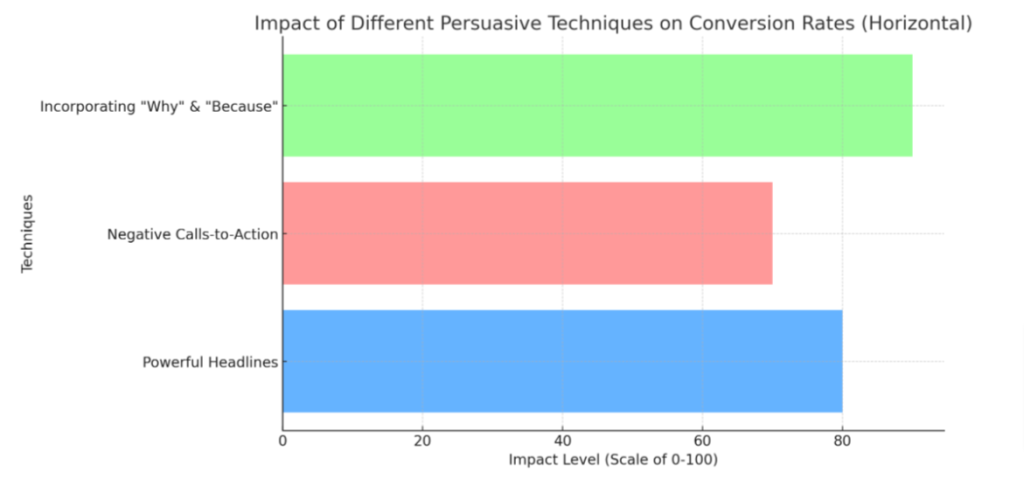Crafting Compelling Copy: The Art of Persuasion in Writing
Struggling to create strong, effective ad copy that converts visitors into customers? You’re not alone. Many marketers grapple with this challenge daily. This blog will provide practical tips on how to write persuasive marketing copy that actually drives conversions.
Ready to transform your writing and boost your conversion rates? Let’s dive in!
Key Takeaways
- Persuasive copywriting is crucial for converting visitors into customers and driving revenue growth.
- Thorough research on target audience and competitors will help craft compelling and tailored copy.
- Starting with the end goal in mind, considering the buyer’s journey, and nailing calls to action are key to writing persuasive ad copy.
- Crafting effective headlines, utilizing negative calls-to-action, and incorporating “why” and “because” statements enhance the effectiveness of persuasive copy.
Understanding Conversion Copywriting
Conversion copywriting is the art of crafting persuasive written content that compels readers to take a specific action, such as making a purchase or signing up for a newsletter. It is an essential skill in digital marketing, as it directly impacts conversion rates and revenue growth.
Definition
Conversion copywriting employs persuasive language to motivate potential customers to take a specific action. This style of writing revolves around creating compelling content that converts casual readers into loyal clients.
The main objective is driving business success by making an offer so intriguing and irresistible, readers can’t help but engage with your brand.
Importance
Conversion copywriting plays a significant role in capturing your target audience’s attention and influencing their decision-making process. It uses persuasive writing that resonates with potential customers, encouraging them to take action – whether it’s signing up for a newsletter, downloading an e-book, or making a purchase.
This emphasis on conversion rate makes the skill of crafting compelling ad copy pivotal in generating revenue growth.
Understanding the importance of effective copywriting techniques extends beyond simply boosting sales numbers. High-quality, persuasive marketing copy enhances brand perception and builds customer loyalty over time.
In addition to fostering an emotional connection with your audience through creative writing, unique selling points highlighted in your content can differentiate you from competitors and position you as an industry leader.
Gripping ad copies create value propositions that are hard for customers to resist; thus improving business sustainability.
ROI potential
Investing in persuasive copywriting can significantly elevate your return on investment (ROI). Businesses often see an uptick in sales and customer conversions after refining their marketing copy.
If done correctly, this strategy works round the clock to attract new customers and convince existing ones to make purchases. A focus on value proposition, unique selling points along with creative, evidence-based success stories woven into the narrative can dramatically amplify conversion rates thereby boosting revenue growth.
Thus, persuasive writing proves to be a cost-effective tool for maximizing ROI potential by driving higher engagement levels and fostering strong customer relationships.
Tips for Creating Persuasive Copy
To create persuasive copy that converts, it is essential to conduct thorough research, starting with the end goal in mind. Consider the buyer’s journey and nail your calls to action.
Additionally, use killer copywriting examples to guide you throughout the process.
Conduct thorough research
To write persuasive copy that converts, conducting thorough research is crucial. By delving deep into your target audience’s needs, desires, and pain points, you can tailor your messaging to resonate with them effectively.
Explore their demographics, psychographics, and purchasing behavior to gain valuable insights for crafting compelling copy. Additionally, researching your competitors’ strategies will help you identify gaps in the market and differentiate yourself through unique selling points.
Armed with this information, you can create persuasive copy that addresses your audience’s specific needs and motivates them to take action.
Start with the end goal in mind
To write persuasive copy that converts, you need to start with the end goal in mind. Clarify what action you want your audience to take after reading your copy. Whether it’s making a purchase, signing up for a newsletter, or filling out a form, having a clear objective will guide your writing and help you craft compelling content that drives conversions.
By focusing on the desired outcome from the beginning, you can tailor your message and calls to action (CTAs) to effectively persuade your target audience and increase conversion rates.
Consider the buyer’s journey
To write persuasive copy that converts, it’s crucial to consider the buyer’s journey. Understand the steps a potential customer takes from being aware of a problem to making a purchase decision.
Tailor your copy to address their needs and concerns at each stage. Start by creating awareness with attention-grabbing headlines and engaging content. Then, provide relevant information and solutions to build interest and desire.
Finally, include strong calls-to-action that encourage action and drive conversions. By aligning your copy with the buyer’s journey, you can create compelling messages that speak directly to your audience’s needs and increase your chances of converting them into customers.
Nail your calls to action
Crafting persuasive copy is important, but without a strong call to action (CTA), your efforts may fall flat. Your CTA is the crucial step that takes your audience from reading to converting.
To nail your calls to action, make them clear and compelling. Use action-oriented verbs that prompt immediate response, such as “buy now” or “sign up today.” Create a sense of urgency by adding time-sensitive language like “limited time offer” or “only available for the next 24 hours.” And don’t forget to highlight the value proposition and unique selling points that make your offer irresistible.
By mastering the art of effective CTAs, you’ll maximize conversions and drive revenue growth.
Use killer copywriting examples
Want to create persuasive copy that converts? Look no further than these killer copywriting examples:
- Nike’s “Just Do It”: This iconic slogan is short, catchy, and encourages action. It taps into the audience’s desire for self-improvement and motivates them to take the leap.
- Apple’s “Think Different”: By challenging the status quo, Apple appeals to those who want to stand out from the crowd. This aspirational message resonates with their target audience and positions Apple as a brand for innovators.
- Airbnb’s “Belong Anywhere”: With this tagline, Airbnb taps into the emotional need for connection and belonging. It evokes a sense of adventure and invites potential customers to explore new places while feeling at home.
- Coca-Cola’s “Open Happiness”: Coca-Cola understands that its product is more than just a beverage; it represents joy and celebration. By associating happiness with their brand, they create an emotional connection with consumers.
- Dollar Shave Club’s “Shave Time, Shave Money”: This catchy phrase highlights both convenience and affordability, appealing to their target market of busy professionals looking for value in their grooming routine.
Writing Persuasive Ad Copy
When crafting persuasive ad copy, it is essential to thoroughly research your audience and the network you are targeting.
Researching your audience and the network
Understanding your audience and the network they belong to is crucial when crafting persuasive ad copy. Take the time to conduct thorough research on who your target audience is, their demographics, interests, and pain points.
This will help you tailor your message specifically to them and speak directly to their needs. Additionally, researching the network where your ads will be placed allows you to understand the platform’s specific rules, limitations, and best practices.
By doing so, you can create ad copy that resonates with your audience and maximizes your chances of conversion.
Crafting effective headlines
Crafting effective headlines is crucial for capturing your audience’s attention and enticing them to read further. Start by understanding your target audience and what appeals to them.
Use powerful verbs and compelling language to create a sense of urgency or excitement. Keep your headlines concise, clear, and relevant to the content that follows. Don’t be afraid to test different headline variations to see which ones generate the best response.
With well-crafted headlines, you can increase click-through rates and ultimately drive more conversions for your business.
Utilizing negative calls-to-action
Utilizing negative calls-to-action is a powerful strategy in persuasive copywriting. By highlighting potential consequences or missed opportunities, you can create a sense of urgency and motivate your audience to take action.
Instead of focusing solely on the positive benefits, incorporating negative language can tap into people’s fear of loss and push them towards making a decision. For example, using phrases like “Don’t miss out!” or “Limited time offer – act now!” can create a sense of scarcity and drive conversions.
When crafting your calls-to-action, consider how emphasizing the negative aspects can be an effective way to grab attention and move your audience closer to conversion.
Incorporating “why” and “because”
Incorporating “why” and “because” into your persuasive copy can greatly enhance its effectiveness. When you provide reasons and explanations for your claims, it helps to convince the reader or customer of the value and benefits of your product or service.
By answering their questions before they even ask them, you build trust and credibility. For example, instead of simply stating that your product is the best in the market, explain why it is superior by highlighting its unique features and how they solve specific pain points.
This way, customers are more likely to see the value in what you’re offering and take action. So remember to always include “why” and “because” statements in your copy to give it that extra persuasive edge.
When incorporating “why” and “because,” make sure to back up your claims with evidence or logical reasoning. This strengthens your arguments and makes them more convincing.
Additionally, focus on addressing the needs and desires of your target audience when using these phrases.
By explaining why they should choose your product or service over others, you tap into their emotions and show them how it can improve their lives or solve a problem they have been struggling with.
Writing with a clear objective
Crafting persuasive ad copy requires writing with a clear objective in mind. Before putting pen to paper, it’s crucial to clearly define the purpose of your copy and what action you want your audience to take.
Whether it’s clicking on a link, signing up for a newsletter, or making a purchase, having a specific goal in mind will guide your writing and make it more impactful. By focusing on your objective, you’ll be able to create copy that is concise, compelling, and ultimately drives conversions.

Measuring and Improving Copy Success
To measure and improve copy success, conduct A/B testing to compare different versions of your copy and see which one performs better. Use ad copy generator tools to generate compelling and effective copy ideas.
Make every word count in your ad copy by focusing on the value proposition and unique selling points. Leverage full-funnel campaigns to drive real results through targeted messaging at each stage of the buyer’s journey.
Finally, don’t forget to dog-food your own marketing by using persuasive copy techniques in your own promotional materials for maximum impact.
A/B testing
A/B testing is a crucial step in measuring and improving the success of your copy. It involves creating two different versions of your ad or webpage and testing them against each other to see which one performs better.
By comparing metrics such as click-through rates, conversion rates, and engagement levels, you can gain valuable insights into what resonates with your audience and make data-driven decisions to optimize your copy for maximum impact.
A/B testing allows you to experiment with different headlines, calls to action, visuals, and other elements to find the most persuasive combination that drives conversions and boosts revenue growth.
Utilizing ad copy generator tools
Ad copy generator tools are valuable resources that can help you create persuasive and compelling copy that drives conversions. These tools offer a range of features and functionalities that make the writing process easier and more effective. By utilizing ad copy generator tools, you can:
- Generate creative and engaging headlines
- Create impactful calls to action
- Incorporate persuasive language and words
- Optimize your copy for maximum impact
- Experiment with different variations of your ad copy
Making your ad copy count
Crafting compelling and persuasive ad copy is essential for driving conversions and maximizing the effectiveness of your advertising campaigns. To make your ad copy count, it’s crucial to thoroughly research your audience and understand the platform you’re using.
Use attention-grabbing headlines that entice readers to click through. Incorporate negative calls-to-action that create a sense of urgency or fear of missing out. Don’t forget to explain why your product or service is valuable, using clear objectives and strong language.
By following these strategies, you can write ad copy that grabs attention, engages readers, and ultimately leads to higher conversion rates.
Leveraging full-funnel campaigns for real results
Leveraging full-funnel campaigns can lead to real results for your business. By targeting customers at every stage of their buying journey, from awareness to conversion, you increase your chances of driving more sales and revenue growth.
Instead of focusing solely on one aspect of the funnel, take a holistic approach and use different marketing channels and strategies to engage with your audience consistently. This allows you to build brand awareness, nurture leads, and ultimately convert them into loyal customers.
So, don’t underestimate the power of full-funnel campaigns when it comes to achieving real results for your business.
Dog-fooding your own marketing.
Implementing your own marketing strategies and techniques can be a powerful way to not only understand their effectiveness but also build trust with your target audience. By “dog-fooding” or using your own marketing tactics, you can gain valuable insights into what works and what doesn’t.
This hands-on approach allows you to identify any gaps in your strategy, refine your messaging, and ultimately improve the conversion rate of your copy. So don’t hesitate to put yourself in the shoes of your audience and test out the persuasive power of your own marketing efforts.

Conclusion
In conclusion, mastering the art of persuasive copywriting is essential for driving conversions and increasing revenue growth. By conducting thorough research, understanding your target audience, and crafting compelling calls to action, you can create copy that truly resonates with your customers.
Don’t forget to measure and improve your copy’s success through A/B testing and leveraging full-funnel campaigns. With these strategies in place, you’ll be on your way to writing persuasive copy that converts like a pro.

